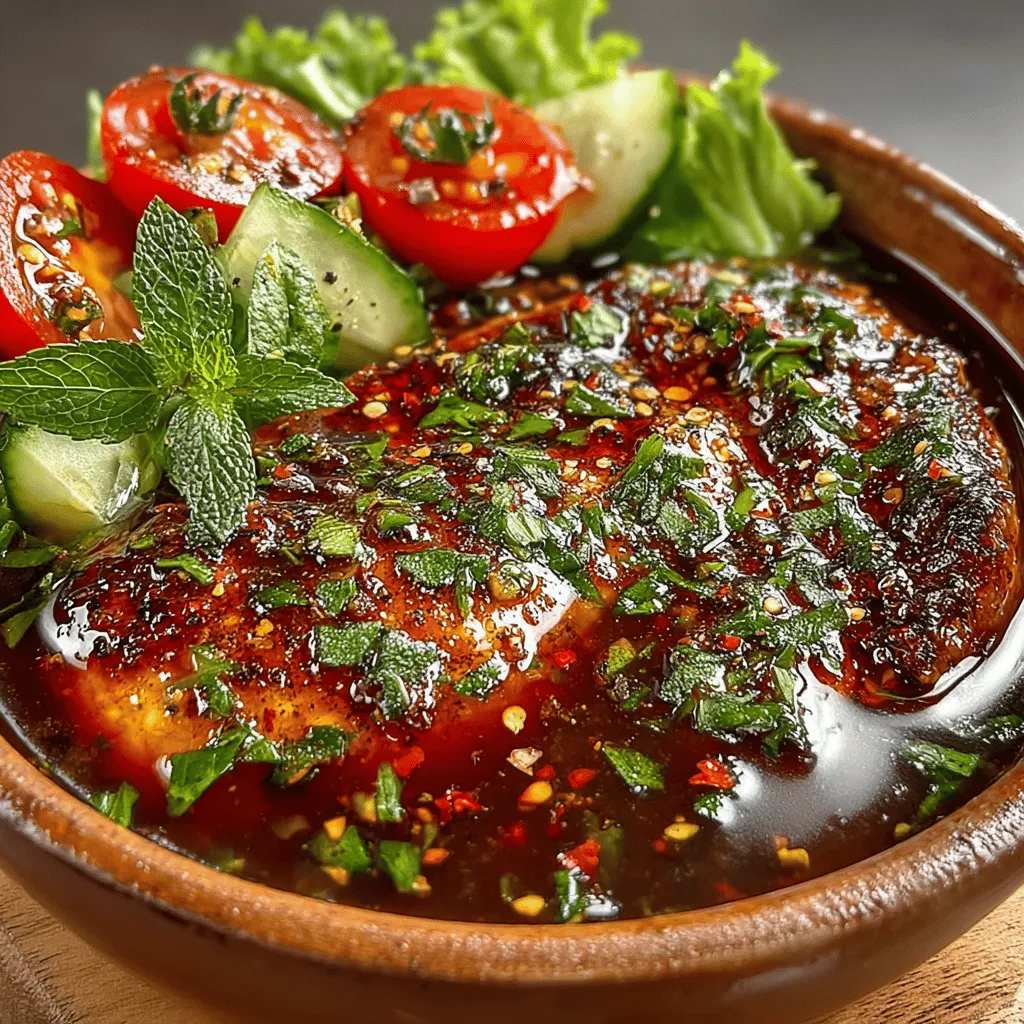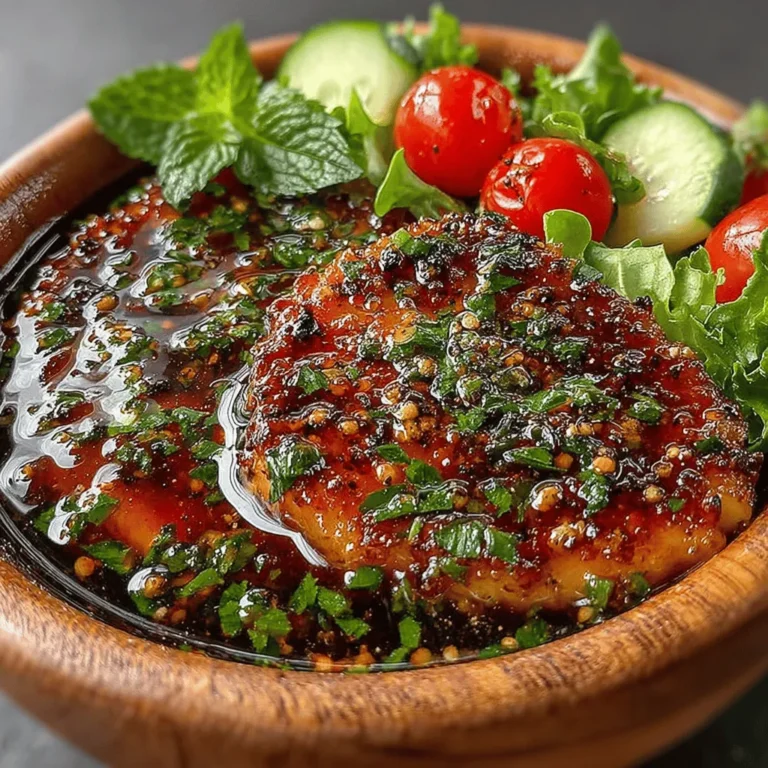Zesty Herb-Infused Fresh Balsamic Vinaigrette: A Flavorful Dressing for Every Occasion
In the culinary world, the right dressing can elevate a simple salad into a gourmet experience. Homemade dressings, in particular, offer an unparalleled freshness and depth of flavor that store-bought varieties often lack. Making your own dressings allows you to control the ingredients, adjust flavors to your liking, and create a product that perfectly complements your dishes. The Zesty Herb-Infused Fresh Balsamic Vinaigrette is a prime example of how a few quality ingredients can come together to create a dressing that not only enhances the taste of salads but can also be used as a marinade, dipping sauce, or drizzled over roasted vegetables.
One of the key components of this vinaigrette is the use of fresh, high-quality ingredients. The difference in flavor between fresh herbs and dried herbs is profound—fresh herbs lend a bright, vibrant quality to the dressing that elevates it to another level. As you embark on this culinary adventure, you can expect a recipe that is not only simple to prepare but also incredibly versatile. Whether you’re tossing it with greens, drizzling it over grilled chicken, or using it to enhance your favorite roasted vegetables, this vinaigrette will undoubtedly become a staple in your kitchen.
Understanding Balsamic Vinaigrette
Balsamic vinaigrette is a popular salad dressing that originated in Italy, specifically in the Modena region, where traditional balsamic vinegar is produced. The term “vinaigrette” itself refers to a mixture of vinegar and oil, often flavored with additional ingredients such as herbs, spices, and sweeteners. What sets balsamic vinaigrette apart is the unique flavor profile contributed by balsamic vinegar, which is characterized by its rich, sweet, and slightly tangy taste.
Historically, balsamic vinegar has been cherished for centuries, dating back to the Middle Ages. It was initially a luxury item reserved for nobility, but its popularity has since spread worldwide. Unlike many commercial dressings that are laden with preservatives, artificial flavors, and sugars, homemade balsamic vinaigrette allows you to savor the authentic taste of quality ingredients without the unnecessary additives. By creating your own version at home, you not only enjoy a fresher flavor but also have the opportunity to tailor the recipe to your dietary preferences and taste buds.
There are numerous benefits to crafting your own balsamic vinaigrette. For one, it often proves to be more economical than purchasing pre-made dressings. Moreover, you can customize the flavor and consistency according to your preferences. Whether you prefer a thicker, creamier dressing or a lighter, more fluid one, the choice is yours. Additionally, homemade vinaigrette is a great way to incorporate nutritional benefits into your meals, as many of the ingredients are packed with health-promoting properties.
Key Ingredients and Their Benefits
To achieve the perfect Zesty Herb-Infused Fresh Balsamic Vinaigrette, several essential ingredients come into play, each contributing its unique flavor and health benefits.
Extra Virgin Olive Oil
The foundation of any vinaigrette is the oil, and in this recipe, extra virgin olive oil takes center stage. The quality of olive oil is crucial, as it dramatically influences the flavor and health benefits of the dressing. Extra virgin olive oil is derived from the first pressing of olives, ensuring that it retains the maximum flavor and nutritional value. Rich in monounsaturated fats, it has been linked to numerous health benefits, including improved heart health and anti-inflammatory properties.
In the context of vinaigrette, olive oil plays a vital role in emulsifying the dressing, allowing it to maintain a consistent texture. The smooth, rich flavor of extra virgin olive oil pairs beautifully with the tanginess of balsamic vinegar, creating a harmonious balance that enhances any dish.
Balsamic Vinegar
Balsamic vinegar is the star ingredient in this vinaigrette, providing a unique flavor profile that is both sweet and tangy. There are various types of balsamic vinegar available, ranging from traditional, aged varieties to more commercially produced options. The best balsamic vinegar boasts a complex sweetness and depth that can transform a simple salad into a culinary masterpiece.
Beyond its taste, balsamic vinegar also offers health benefits. It is low in calories and contains antioxidants that can help combat oxidative stress in the body. Additionally, its acetic acid content has been shown to aid digestion and may even help regulate blood sugar levels. By incorporating balsamic vinegar into your vinaigrette, you not only enhance flavor but also boost the nutritional value of your meals.
Dijon Mustard
Dijon mustard serves a dual purpose in this vinaigrette: it acts as an emulsifier and enhances the overall flavor profile. The sharpness of Dijon mustard adds a zesty kick that beautifully complements the sweetness of balsamic vinegar. Moreover, it helps to stabilize the vinaigrette, preventing the oil and vinegar from separating.
Nutritionally, Dijon mustard is low in calories and can be a great source of several essential minerals, including selenium and magnesium. Its unique flavor elevates the vinaigrette while also adding a touch of sophistication, making it a must-have in your ingredient list.
Honey vs. Maple Syrup
Sweetness is an essential component of a well-balanced vinaigrette, and you have options when it comes to sweetening agents. Both honey and maple syrup can be used in this recipe, allowing you to cater to different dietary needs and preferences. Honey adds a floral sweetness that pairs wonderfully with the other flavors, while maple syrup provides a rich, earthy note that can enhance the overall depth of the dressing.
From a health perspective, both options offer nutritional benefits. Honey is known for its antimicrobial properties and is often used for its soothing effects on the throat, while maple syrup is a good source of antioxidants and essential minerals, including manganese and zinc. Choosing between honey and maple syrup ultimately comes down to personal preference and dietary restrictions, making this vinaigrette adaptable to various tastes.
Garlic
Garlic is another key ingredient in the Zesty Herb-Infused Fresh Balsamic Vinaigrette, contributing a robust flavor that complements the other ingredients beautifully. Its aromatic qualities can elevate the vinaigrette, giving it a savory depth that enhances the overall experience.
Beyond its culinary uses, garlic is renowned for its health benefits. It contains allicin, a compound known for its anti-inflammatory and immune-boosting properties. Including garlic in your vinaigrette not only adds flavor but also infuses your dressing with health-promoting attributes that can support overall wellness.
Initial Steps to Make the Vinaigrette
Now that we’ve explored the key ingredients and their benefits, it’s time to dive into the initial steps of making your Zesty Herb-Infused Fresh Balsamic Vinaigrette.
1. Gather Your Ingredients: Start by assembling all the ingredients you’ll need. This includes high-quality extra virgin olive oil, balsamic vinegar, Dijon mustard, your choice of honey or maple syrup, fresh garlic, and a selection of fresh herbs such as basil, parsley, or thyme.
2. Prepare the Fresh Herbs: Rinse and chop your chosen fresh herbs finely. The quantity can vary depending on your preference, but a combination of herbs will provide a more complex flavor profile.
3. Mince the Garlic: Take a clove of garlic and mince it finely. If you prefer a milder garlic flavor, you can reduce the amount or even roast the garlic beforehand to soften its pungency.
4. Mix the Ingredients: In a mixing bowl, combine the balsamic vinegar, Dijon mustard, honey or maple syrup, and minced garlic. Whisk these ingredients together until they are well blended.
5. Add Olive Oil: Slowly drizzle in the extra virgin olive oil while continuing to whisk the mixture. This step is crucial for emulsifying the vinaigrette, ensuring that the oil and vinegar combine smoothly.
6. Incorporate Fresh Herbs: Once the oil is fully incorporated, fold in the chopped fresh herbs. Give the vinaigrette a final whisk to ensure everything is well combined.
In the next part of this article, we will delve deeper into the finishing touches for this vinaigrette, including tips for storage, variations, and how to best use it in your culinary creations. Stay tuned for a flavorful journey that will transform your salads and dishes into something extraordinary.

Creating your own salad dressing at home can elevate your meals, adding freshness and flavor that store-bought varieties simply can’t match. Among the myriad of options, a zesty herb-infused balsamic vinaigrette shines brightly. This versatile dressing not only enhances salads but also serves as a delightful marinade and dipping sauce. In this section, we will delve into the ingredients that give this vinaigrette its distinctive taste, provide a detailed step-by-step guide for making it, suggest some delicious serving options, and discuss how to store your vinaigrette properly.
Fresh vs. Powdered Garlic: Flavor Differences
When it comes to garlic in your vinaigrette, freshness is key. Fresh garlic packs a robust, vibrant flavor that powdered garlic simply cannot replicate. The pungency of fresh garlic adds a sharp bite that complements the sweetness of balsamic vinegar beautifully. Additionally, fresh garlic retains moisture, which helps in creating a more balanced emulsion with the vinegar and oil.
In contrast, powdered garlic is dehydrated and has a milder flavor. While it can still contribute to the overall taste, it lacks the complexity and aromatic intensity of fresh garlic. For the best culinary experience, always opt for fresh garlic in your vinaigrette.
Health Benefits of Garlic
Beyond its flavor, garlic is renowned for its numerous health benefits. It is rich in antioxidants and contains compounds such as allicin, which have been linked to reduced blood pressure and improved heart health. Garlic also possesses antimicrobial properties and may boost the immune system, making it a fantastic addition to your diet.
Fresh Lemon Juice
In any vinaigrette, acidity is essential for balancing flavors. Fresh lemon juice adds a bright, tangy note that complements the sweetness of balsamic vinegar while enhancing the overall taste experience. The acidity helps to cut through the richness of the oil, leading to a well-rounded dressing.
Nutritional Benefits of Fresh Lemon
Fresh lemon juice is not only delicious but also packed with health benefits. It is an excellent source of vitamin C, which supports the immune system and aids in collagen production for healthy skin. Additionally, lemons contain citric acid, which may help prevent kidney stones and improve digestion. Including fresh lemon juice in your vinaigrette not only perks up the flavors but also contributes to your overall health.
Dried Oregano and Basil
The dried herbs, oregano and basil, play pivotal roles in enhancing the flavor profile of your vinaigrette. Oregano brings an earthy, slightly peppery flavor that complements the acidity of the vinegar beautifully. Its robust profile pairs well with the sweetness of balsamic vinegar, creating a harmonious blend.
On the other hand, dried basil adds a sweet and slightly floral note, elevating the vinaigrette’s complexity. Together, these herbs create a classic Italian flavor, making this vinaigrette a perfect companion for various salads.
Health Benefits of Herbs
Herbs like oregano and basil are not only flavorful but also packed with health benefits. Oregano is rich in antioxidants and has anti-inflammatory properties. It may also promote digestive health and has been shown to have antibacterial effects. Basil, too, is loaded with antioxidants and has anti-inflammatory properties. It can help reduce stress and improve mood, making your salad not just a meal but a health-boosting experience.
Step-by-Step Guide to Making Zesty Herb-Infused Fresh Balsamic Vinaigrette
Creating the perfect zesty herb-infused balsamic vinaigrette requires attention to detail and a few essential steps. Follow this comprehensive guide to ensure your dressing turns out delicious every time.
Ingredients Needed
– 1/2 cup balsamic vinegar
– 1/4 cup extra virgin olive oil
– 2 cloves fresh garlic, minced
– 1 tablespoon fresh lemon juice
– 1 teaspoon dried oregano
– 1 teaspoon dried basil
– Salt and pepper to taste
Preparation Process
1. Prepare the Ingredients: Start by gathering all your ingredients. Mince the fresh garlic and measure out the balsamic vinegar, olive oil, lemon juice, and dried herbs.
2. Combine Vinegar and Garlic: In a medium mixing bowl, pour in the balsamic vinegar and add the minced garlic. Let this mixture sit for about 5 minutes. This step allows the garlic to infuse its flavor into the vinegar, enhancing the overall taste of the vinaigrette.
3. Add the Herbs and Lemon Juice: Next, add in the dried oregano, dried basil, and fresh lemon juice. Whisk the mixture to combine the ingredients thoroughly.
4. Incorporate Olive Oil: With your whisk still in action, slowly drizzle in the olive oil. This is where the magic of emulsification happens. Whisk vigorously as you add the oil, ensuring that it blends seamlessly with the vinegar mixture.
5. Season to Taste: Once the oil is fully incorporated, taste your vinaigrette. Season with salt and pepper according to your preference. Remember that the flavors will meld as the vinaigrette sits, so start with a little seasoning and adjust as needed.
6. Store or Serve: If you’re not using the vinaigrette immediately, transfer it to a clean glass jar with a tight-fitting lid. Otherwise, pour it over your favorite salad right away!
Importance of Each Step
Each step in this process is vital to achieving the perfect emulsion and flavor balance. Allowing the garlic to infuse in the vinegar lays a strong foundation of flavor. The slow addition of olive oil while whisking is crucial for creating a stable emulsion, preventing the oil from separating from the vinegar. Finally, seasoning at the end allows you to fine-tune the flavor profile to your liking.
Tips for Adjusting Flavors Based on Personal Preference
Feel free to experiment with the proportions of vinegar and oil based on your taste preferences. If you prefer a tangier vinaigrette, increase the balsamic vinegar slightly. If you enjoy a richer flavor, add more olive oil. You can also experiment with additional herbs or spices, such as thyme or red pepper flakes, for added complexity.
Serving Suggestions
Your zesty herb-infused balsamic vinaigrette is incredibly versatile, making it suitable for a variety of dishes. Here are some great serving suggestions to help you get the most out of this delicious dressing:
Pairing the Vinaigrette with Different Salads
This vinaigrette is an excellent accompaniment to mixed green salads, particularly those featuring ingredients like fresh tomatoes, cucumbers, and feta cheese. It also works beautifully with grain-based salads, such as quinoa or farro, adding a burst of flavor that elevates the entire dish.
Alternative Uses
Beyond salads, consider using your vinaigrette as a marinade for grilled chicken, fish, or tofu. The acidity in the vinaigrette helps tenderize proteins while infusing them with flavor. You can also drizzle it over roasted vegetables or use it as a dip for fresh bread or vegetable platters.
Seasonal Salad Ideas That Complement the Vinaigrette
In spring and summer, pair your vinaigrette with a refreshing salad of mixed greens, strawberries, and goat cheese. For autumn, consider a roasted beet and arugula salad topped with walnuts and crumbled blue cheese. In winter, a hearty kale salad with roasted squash and pumpkin seeds is a perfect match for this zesty dressing.
Storing and Preserving Your Vinaigrette
To ensure your homemade vinaigrette remains fresh and delicious, proper storage is essential.
Best Practices for Storing Homemade Vinaigrette
Store your vinaigrette in an airtight container, such as a glass jar or bottle, in the refrigerator. This will help maintain its freshness and flavor.
Shelf Life and Signs of Spoilage
Homemade vinaigrette can last for about 1 to 2 weeks in the fridge. However, always check for signs of spoilage before using it. If you notice any off odors, changes in color, or separation that doesn’t mix back together, it’s best to discard the vinaigrette.
How to Properly Shake or Stir Before Serving
Before serving, give your vinaigrette a good shake or stir to recombine the ingredients, as they may have separated during storage. This will ensure that the flavors are evenly distributed throughout the dressing.
Conclusion
Making your own zesty herb-infused balsamic vinaigrette offers a multitude of benefits—from enhanced flavor to improved nutrition. This simple yet delightful dressing can transform salads and elevate various dishes in your culinary repertoire. Don’t be afraid to experiment with different flavors and ingredients, as homemade dressings allow for creativity and personalization.
Incorporating fresh, high-quality ingredients like garlic, lemon juice, and dried herbs not only boosts flavor but also contributes to your overall health. So, grab your whisk and start creating your own wonderful vinaigrette at home. Experience the joy of making your own dressings and the positive impact they can have on your meals. Enjoy the journey of flavor exploration and find your perfect balance!


